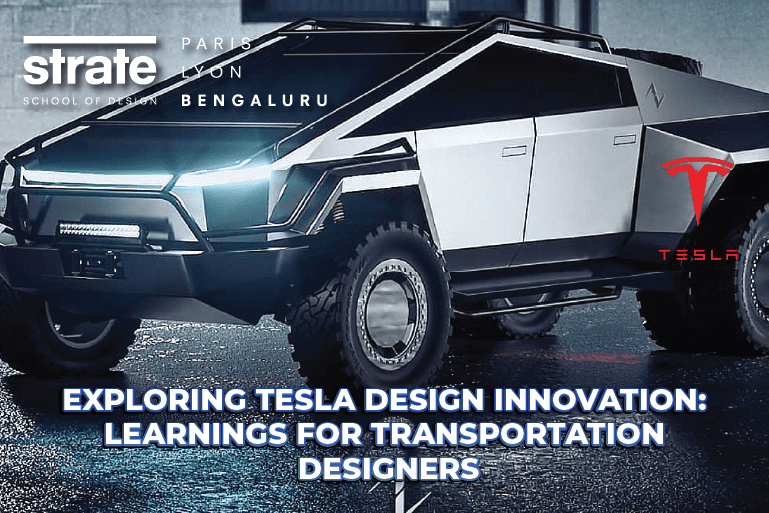The fascinating field of transportation design is undergoing a revolutionary change with the emergence of new-age technology solutions. Propelling the sector towards sustainable mobility solutions and disruptive user-centric experiences. Transportation design covers all aspects such as automobile design, smart traffic networks, connected vehicles, routes, and services connected to them. Today, it is about building new design solutions that have an inherent nature of being efficient, carbon neutral, and futuristic.
Tesla is a leading name in the space of sustainable and futuristic design solutions. Under the leadership of business mogul Elon Musk, Tesla emerged as a trailblazer with its electric vehicles. From designing the striking appearance of the EVs at Tesla to the ergonomics and aesthetics of automobiles, the brand is a great case study for young designers.
Tesla’s design innovation
The remarkable success of the brand lies in its approach to integrating many design, sustainable, and technology solutions. The ground-breaking EV design and sustainable energy solutions are what differentiates Tesla in the EV market. Here are some of the classic features that help it stand out:
a. Solar energy solutions reducing carbon footprint
b. Futuristic vehicle design with minimal aesthetics
c. EVs with panoramic glass roofs
d. Vegan leather and recycled plastic in its interior design
e. Autopilot features with adaptive cruise control
f. Over-the-air software updates
g. Enhanced user experience with large touch screens to display control functions.
Tesla’s successful design-thinking strategy
Tesla has a successful implementation strategy of the design thinking principles. The design thinking principles have redefined Tesla’s take on EVs paving the path for a greener industry. Becoming a winning strategy behind its revolutionary products, here are the five stages in design thinking where Tesla shines:
1. Empathize
Tesla begins its design journey with a deep understanding of its customers. The brand is known to listen to EV enthusiasts and its potential buyers. Identifying their needs, concerns, and expectations. Helping them to empathize with the target market and designing EVs that address real-world challenges.
For instance: The Charging infrastructure revolution by Tesla: Tesla listened to understand and recognize the range anxiety in the customers, limited availability or lack of charging infrastructure, and other related concerns on performance. Leading the brand to address the concerns by investing in building a robust Supercharge network. Offering users fast and convenient charging options at strategic locations on popular routes. Tesla alleviated user concerns with an active design thinking approach to address the challenges.
2. Define
The next step is to define the challenges, needs, and opportunities. This also means the brand defines what it sets out to achieve with its design strategy. Tesla here defined clearly that it sets out to redefine the perception and experience of EVs. Designing for sustainable revolution in transportation. Building eco-friendly, carbon-neutral, and high-performance machines.
3. Ideate
At Tesla, ideation involves innovation and disruption. The brand culture encourages cross-functional teams for brainstorming and ideation. Like designers working with technology experts and scientists. This collective approach gives rise to disruptive and revolutionary concepts.
For instance: The Tesla Roadster, the brand’s first sports car is a collective approach successful idea designed into an actual product. Another example is the brand’s Autopilot driving system – which is a semi-autonomous driving system at the top of its class, differentiating Tesla from its competition.
4. Prototype
Iterative prototyping is how Tesla is on a continuous path to redefine and enhance its user experiences. This stage enables the brand to experiment with vehicle design, ergonomics, user experiences, battery technology, and autonomous features. The brand can fine-tune the elements before the vehicle reaches a production stage.
For instance: Tesla Roadster, the first product from Tesla was a result of iterative prototyping. Tesla Roadster showcases Tesla’s commitment to high-performance and stimulating driving experiences. They engaged in a continuous feedback loop and iterative prototype cycle to hone the design, user experiences, panoramic roof design, battery technology, range, and charging capabilities.
5. Testing
The last stage is about Tesla actively testing its innovation in the real world. This means gathering user feedback and testing vehicles on the road under various conditions. Tesla experts then make iterative improvements basis the gathered feedback.
For instance: Tesla’s introduction of over-the-air software updates for its Autopilot reflects its commitment to continuously testing and improving vehicle functions.
The brand fosters creativity, exploration, and collaboration throughout its design thinking approach. It’s rigorous testing and tireless prototyping are driving forces behind transformative changes in the EV sector.
Tesla’s focus on Sustainability
Tesla is deeply committed to sustainable innovation and sustainable design. Extending sustainable conversion in EV beyond the electric propulsion. The brand incorporates sustainable technology in every aspect of the vehicle design. Demonstrating their commitment to digital environmental impact and reducing carbon footprint.
Their sustainable solutions include:
a. Lithium-ion battery packs: They are high-capacity and long-lasting
b. Renewable energy solutions at their Gigafactories that produce batteries.
c. Vegan Leather for the interiors
d. Recycled plastic for accessories and interior design
e. Minimal design, one that is sleek, simple, and efficient. Enhancing the aesthetic appeal and overall reduction in material usage.
Tesla’s sleek vehicle design and exceptional UX
User experience (UX) is the true centrepiece of Tesla. Its sleek design, minimal interiors, intuitive touchscreens, and defining panoramic roofs are designed to delight the users. The clean lines, intuitive control functions, and no clutter in the interior space offer users a sense of space and calm – enhancing their overall driving experience. Exuding a true blend of sustainability, luxury, and style, Tesla has revolutionized the perception of EVs. Designing vehicles without compromising on aesthetics, driving pleasure, or luxury appeal.
Tesla’s impact on the industry
Tesla’s impact goes beyond its success. Its revolutionary innovations and disruptions across EVs have inspired many automakers to follow a sustainable path.
– With their successful innovations, Tesla has increased the desirability and viability of EVs
– It has paved the way for established competition to pivot their strategies on building more sustainable mobility solutions.
– Accelerated the adoption of EVs across global cities.
– Tesla’s innovations are constantly driving the transportation sector towards a green technology future with a zero-carbon footprint.
One of the key learnings for aspiring transportation designers is how Tesla merges design, sustainability, and technology into all its elements. Its continuous commitment to innovation is reflected in its design thinking strategy. Which is helping them to push boundaries, think out of the box, and build a collective community with Tesla users. It’s known to have made almost 20 engineering changes every week to its Model S vehicle by listening to what customer tells them about the driving experiences.
Gathering insights from the data collected on how customers use their cars. From investing in charging infrastructure, prioritizing sleek design and UX, and integrating sustainable mobility solutions, Tesla has fundamentally changed the automobile sector.
Become a Transportation Designer with Strate School of Design’s leading global immersion programme. You can join:
a. Bachelors in Transportation Design
b. Masters in Transportation Design, and
c. 5-year integrated Bachelor’s and Masters’ programme.
Gain industry insights, work on live projects with leading brands, and immerse in international student exchange programmes. Reach us here to learn more about the programmes.



Want to Become a Designer ?
Strate is a unique design school that nurtures your talents as a designer by offering state-of-the art designing courses in Bangalore.
Join Strate